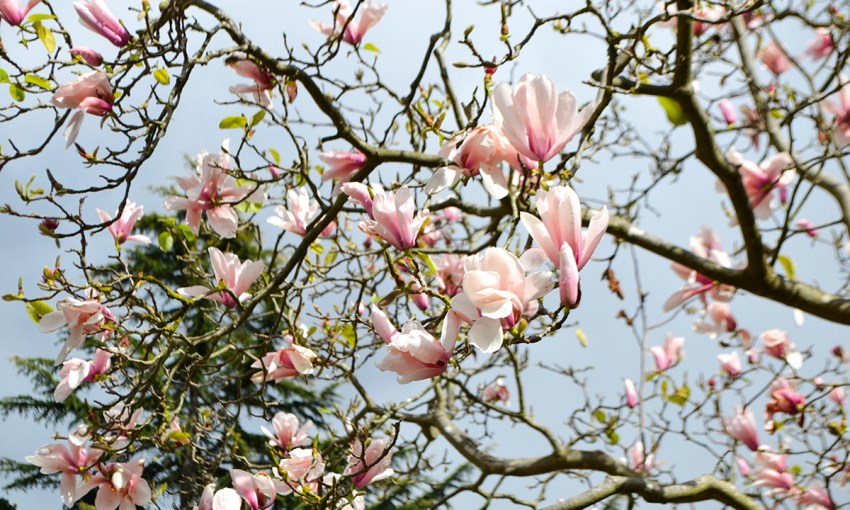There are few trees that produce large, flamboyant flowers so dramatically displayed on bare branches as the magnolia.
In the garden: Magnificent magnolias
There is no equal to the magnificence of an established magnolia tree. The family Magnoliaceae is a large and varied genus consisting of around 100 species of both deciduous and evergreen trees. These occur naturally throughout Asia and North America. Countless cultivars have resulted from the best of this species.
Plant hunters of the 18th century originally found these huge-flowered trees in the Himalayas and central China; they knew they had discovered something special. Magnolia flowers are associated with nobility, perseverance, dignity and a love of nature.
Deciduous magnolias
These trees have a spectacular habit of producing their blooms on naked stems in late winter to announce the arrival of spring. The best known deciduous magnolias produce large tulip-shaped flowers, but they can vary with different varieties producing goblet, champagne flute and star-shaped flowers.
The exciting news is that recent breeding has seen the development of a range of new magnolias that are even more spectacular. Many new cultivars have large, richly-coloured and mostly fragrant blooms. The colour range has been expanded to include bright pinks, lemon yellows, vivid purples, rich burgundy and the purest of whites.
Where to plant
An eastern or southern aspect is perfect. Given well-prepared, fertile, humus-rich, well-drained soil, deciduous magnolias will do best when offered protection from damaging winds. Eastern and southern facing gardens often provide the best opportunity to grow a magnolia. They enjoy all morning sun, but are best out of the ravages of our hot afternoon sun.
Deciduous magnolias have shallow feeder roots, so mulch well and avoid cultivating around them. Magnolias generally won’t disturb underground pipes, footings, foundations or pathways. However plant with plenty of room for the tree to develop its sizable trunk.
It’s vital to keep magnolias well-watered during dry periods and in the heat of summer. Once established, they are resilient, but still require regular summer watering.
Applying fertiliser will give your magnolia the food and energy it needs to produce strong growth and excellent flowers. Mulching in summer will help stop the leaves from developing excessively dry edges that are noticeable in our climate, however if burnt foliage occurs in late summer this is generally nothing to worry about.
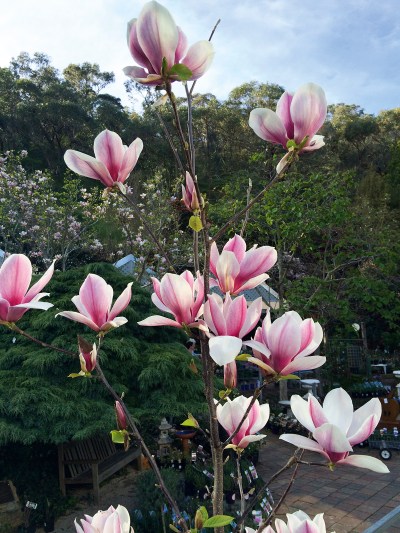
Magnolia x soulangeana cultivars such as “Burgundy Glow”. White shading to mauve pink towards the base of beautifully formed tulip-shaped flowers. These are borne in profusion along bare winter branches; this is one of the most popular varieties and the most frequently seen in Adelaide gardens. Grows to six to eight metres high.
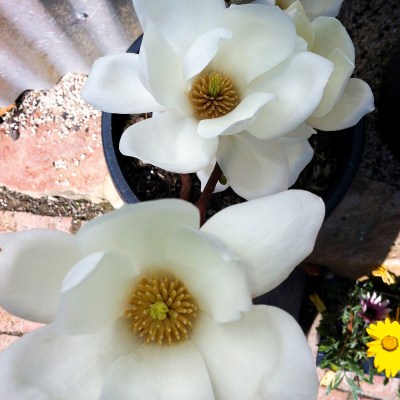
Magnolia Denudata Buddhist monks in China planted this at their temples as early as 650 A.D. Their white flower symbolises purity. One of the first to bloom in winter.
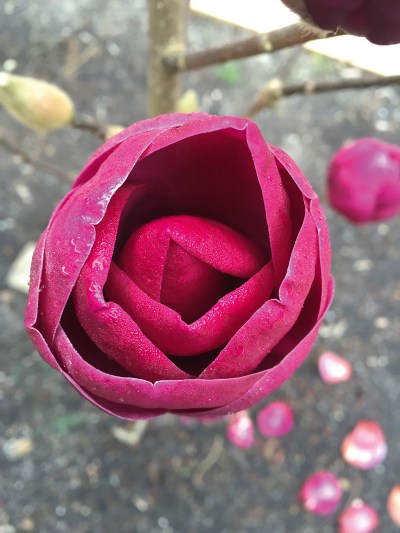
Magnolia “Black Tulip” One of the most stunning magnolias of the recently released “Jury Magnolias” from New Zealand. An upright tree to only about five metres, large light green foliage followed by stunning rich purple goblet-shaped blooms on bare winter branches.
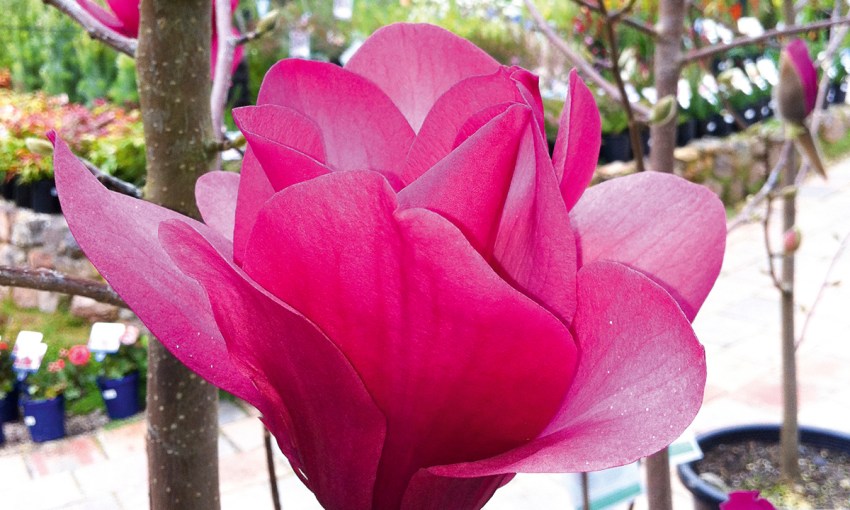
Magnolia “Vulcan” Another of the Jury Magnolias, one of the new dark mauve to dark purple varieties. Outstanding large cupped goblet-shaped double bloom. I have measured flowers at 20cm across. This one will take your breath away.
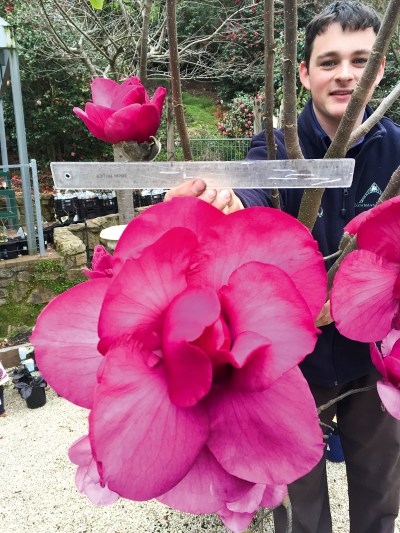
Magnolia “Felix” Possibly the best of the Jury Magnolias. Stunning hot mauve pink double blooms, up to 30cm across, make them the largest flowers of any magnolia. The tree grows to a stout upright pyramid shape to around five metres. As with other magnolias, flowers occur on bare branches before the spring foliage appears, creating a most striking feature in a winter/spring garden.
Magnolia “Stellata” A miniature variety to just over one metre, masses with small white star-shaped flowers. Hardy and perfect for a deciduous hedge with a difference. A beautiful soft pink form called Leonard Messel can be obtained also.
Evergreen magnolias
Evergreen magnolias also prefer a moist, fertile and well-drained soil that is slightly acidic, so when planting it helps if the soil has been prepared. They differ from the deciduous magnolias in so far as they will take a sunny aspect, though they do tolerate partial shade well.
We advise the application of good quality fertiliser in spring, summer and again in early autumn. Mulching and watering during the drier months, especially when the plant is establishing itself, is essential. Once established in the landscape they prove to be a very tough plant that is capable of enduring heat and low levels of frost.
If you are looking for fire retardant trees, consider magnolia grandiflora and any of its cultivars. Evergreen magnolias can assist with fireproofing your property and can be an integral part of your fire plan.
Magnolia grandiflora “Bull Bay” One of the most magnificent evergreen trees available, it perfumes your garden. Develops into a large round-headed tree with big, glossy green leaves. The large creamy white flowers can reach 25cm across. Best for large gardens. As with all evergreen magnolias, blooms can be used in flower arrangements. Grows to 10 metres plus and is also the parent of all the cultivars below.
Magnolia grandiflora “Kay Parris” A little smaller and more compact than Little Gem to around four metres high.
Magnolia grandiflora “Alta” This is an elegant upright form growing to around nine metres, taking on a narrow conical shape with all the qualities of the other grandiflora varieties, well suited to narrow gardens.
Magnolia grandiflora “Little Gem” An extremely popular small tree, used as screening or as a specimen. Beautiful, glossy, thick green leaves with that rusty, reddish-brown reverse. Can grow to five metres and has large creamy-white perfumed flowers. Ideal in the garden or equally at home in a large tub. Designers and landscapers have a love affair with this special magnolia – and there is no doubt why.
Magnolia grandiflora “Green Back” A majestic tree to around eight metres and, as the name suggests, has a green back to the leaf.
Magnolia grandiflora “Teddy Bear” Similar to Little Gem in many respects but smaller and more compact with slightly larger leaves with a rounded end. Height is around three metres. It makes a perfect garden specimen, great for small hedges and a stunning
pot subject.
This story first appeared in the Spring 2018 issue of SALIFE Gardens & Outdoor Living magazine.



